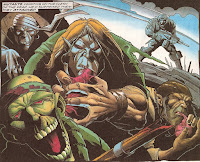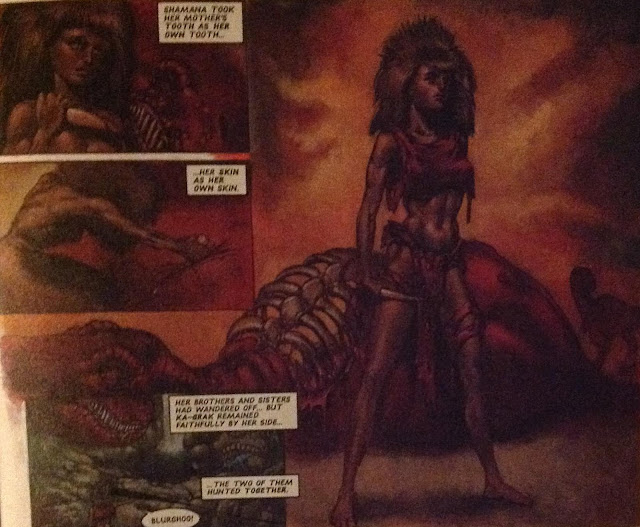First Prog: 647
Latest Prog: 1948
First Meg: 3.66
(aka 170)
Latest Meg: 230
Total appearances: 126
-including the ‘Funeral for a
Friend’ poster strip bagged with a Megazine one time.
but not including the IDW Judge Dredd: Year 1 series (although
it’s worth noting that’s the best thing yet to come from the IDW Dredd-iverse).
 |
| Embracing the trope of Dredd as proper bastard Words by Garth Ennis |
Creator Credits:
Jaegir
Bato Loco
Other art credits:
Universal Soldier
Judge Dredd
Rogue Trooper (both versions)
Venus Bluegenes
The Simping Detective
Malone
Malone
Low Life
Notable character creations:
Bato Loco
Rafaella Blue (I think he drew
her first?)
Atalia Jaegir
Notable characteristics:
Characters of glorious
ugliness. Sideways slanty mouths. Action that draw the reader across the page.
There’s surely a better word for it, but his current style brings to mind the
word ‘gnarly’.
Oh, and having a super-recognisable somewhat plasticy old style:
 |
| Well-defined lines, straight up cartooning |
Followed by a years-later, recognisable but super-different grizzly style:
 |
| Moodier, darker, more morally ambiguous. |
On Simon:
Simon Coleby has
proved the longest-serving of a great wave of Simons* who joined 2000AD in the
late 80s / early 90s. He’s also undergone perhaps the most radical re-invention
of the all. Basically, there’s early Simon Coleby, who is chunky and garish
and angular and action packed (and a ton of fun). And mostly in full colour.
 |
| A very simple face design that conveys all you need to know about this dude right here. Words by Alan McKenzie |
Then there’s
contemporary Simon Coleby, who’s equally action-packed, but also
super-detailed, scary, moody, and kind of amazing. And mostly in black and
white.
 |
| The new style - requires 150% more ink. This time, character is conveyed in clothing and body language as well as the faces. Words by Rob Williams |
(Arguably not quite as big a shift as his contemporary
Carl Critchlow, but that’s mostly because Critchlow started out painting, so it’s
much more obvious how different it is. Still Coleby’s new stuff has a whole
different bag of tricks from his old stuff.)
It’s not fair to speak
ill of an artist in their early days, but I will say that I found something about
Coleby’s early stuff, along the lines that it felt like I might just be able to
draw like him. Not to say that he wasn’t a good draughtsman, but I found his
style unintimidating; his storytelling very straightforward. This is probably
most apparent in his very first story, Universal
Soldier II. Where the first book by Will Simpson was rain-soaked, a bit
grimy and sometimes tough to follow, Coleby’s Book II was refreshingly easy. In
all honesty, I hadn’t a clue about the back story when I first read it, but
taken on its own as a sort of post-Robin Hood pre-Braveheart war story, it was
jolly fun.
 |
| Check out how everything slopes a little bit down and to the right. Basic dynamism, or a wonky desk? Words by Alan McKenzie |
Coleby started pushing
the boat out when he moved to Dredd and FrIday-era Rogue Trooper. He started pulling
faces this way and that, unafraid to embrace the old cartoonist standby of
exaggeration. If it sometimes erred too far into silly, so be it. I mean, what
else do you do when the story calls for a character with a detachable jaw big
enough to swallow a fat man whole?
Actually, what really
stuck out to me as a young reader were Coleby’s faces. Particularly the mouths.
Even more particularly, the constant downward slope.
You could also argue a case for Coleby following contemporary fashions for mega-muscled body-builder types, along with endless spraying bullets. Coupled with grimaces. Certainly Dredd at the time was falling into this pattern. Coleby I think fit the bill well, not least with his facility for drawing moronic cits (and arguably a few not-too-smart bureaucrats, too).
 |
| So many bullet cartridges! More sloping foreheads! Words by Michael Fleisher |
 |
| Who you callin' fish lips, lady? Words by Dan Abnett |
 |
| Rogue Trooper: cool, original flavour. |
 |
| You want an angry bad guy face? I'll give you an angry bad guy face!! Words by Gordon Rennie |
 |
| Chunky guns, thick-soled boots, massive zip - yup, this girl's ready for a career in 2000AD. Words by Gordon Rennie |
Over in the Meg, and
still with Rennie for much of it, Coleby made a return to the world of Dredd. Sticking
with the new style, it’s perfectly made to capture old, grizzled Dredd.
Something about the way Coleby adds in shadows and wrinkles everywhere. It’s
not that his Dredd is super-aged looking (as some artists have it), more that
everything about him, from chin to boots, is gnarled.
 |
| Just a deliriously fun angle to highlight a comedy chase. Words definitely by Gordon Rennie |
BUT Rennie I think
knew what he was doing. He’s working in a Wagner/Grant tradition of equal
opportunities laughing at everyone, and in fact bringing some diversity of
character in. Above all, Bato Loco as
a story is a comedy effort, with the hero’s own attitude (and idiocy) being the
point, coupled with absurdly convoluted plot machinations not some suggestion
that this is in fact endemic to all Puerto Rican New Yorkers or what have you.
I hope.
Coleby, of course, was
along for the ride of drawing pictures to sell the character and his womanizing
ways, which he does very adeptly.
On to Malone, in which a man with a past
attempts to rescue a troubled waif but is haunted by visions of an especially
terrifying clown. We all know what it means now,
sure, but at the time it was pretty odd. It read like a standard noir story,
but the clown, and indeed a heightened atmosphere added by Coleby, gave it
something of the horror. It all clicked
together especially well.
Coleby next clicked
well with Rob Williams on Low Life.
I’m not sure if it was either man’s intention or desire, but as a pair they
moved the strip from a serious action story that investigated doubt into a
comedy action story that investigated the depths of weirdness of MC-1, with
unusual characters being the order of the day – characters that dominate the
plot, to be frank (pun intended, I guess).
 |
| Babies that actually look like babies! Not often as well-handled as Coleby manages here. Words by Rob Willaims |
Crucially, all these
outings were in black and white. It’s a good fit for Coleby, but something about
his heavily inked style can occasionally make the foreground and background
blend together, losing a modicum of clarity. I don’t think this was a direct
cause, but since then we’ve seen first the odd splash of colour in Simping Detective,
and then full-on
mood-enhancing cover on Jaegir,
Coleby’s fourth outing into the world of Rogue
Trooper (which I guess makes him the artistic curator of that Universe at
this point).
Jaegir is inhabited by monsters of all stripes, both physically and
emotionally. That gnarliness is front and centre. Coleby does an especially
standout job on showing the characters’ inner turmoil.
Comedy and Tragedy, Action and Emotion - he makes it look easy!
More on Simon Coleby:
An IDW-hosted interview mostly
about his IDW Dredd
iFanboy has a piece,
opening with the question of whether this 25-year career artist counts as an
upstart…
Personal favourites:
Judge Dredd: School Bully; The Flabfighters; My beautiful career
Universal SoldierII
Friday: I retain a soft spot for the Saharan Ice Belt war.
Rogue Trooper: all Coleby’s episodes in the Rennie series were
spectacular
Malone: probably my all-time fave of Coleby’s work.
Bato Loco: always a treat
Low Life: Rock and a Hard Place
Jaegir: I’m not 100% on board with this series, but the art is stellar.
*Harrison; Bisley;
Jacob, Davis,
and, a little later, Fraser. And perhaps the mysterious SMS. (Not to mention
writers Geller, Furman, Spencer and Spurrier)






















































